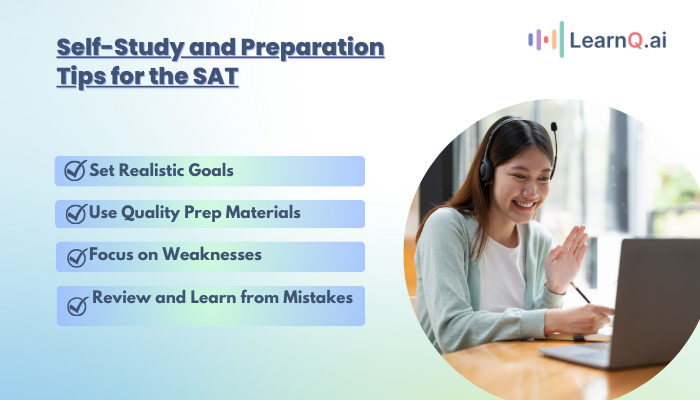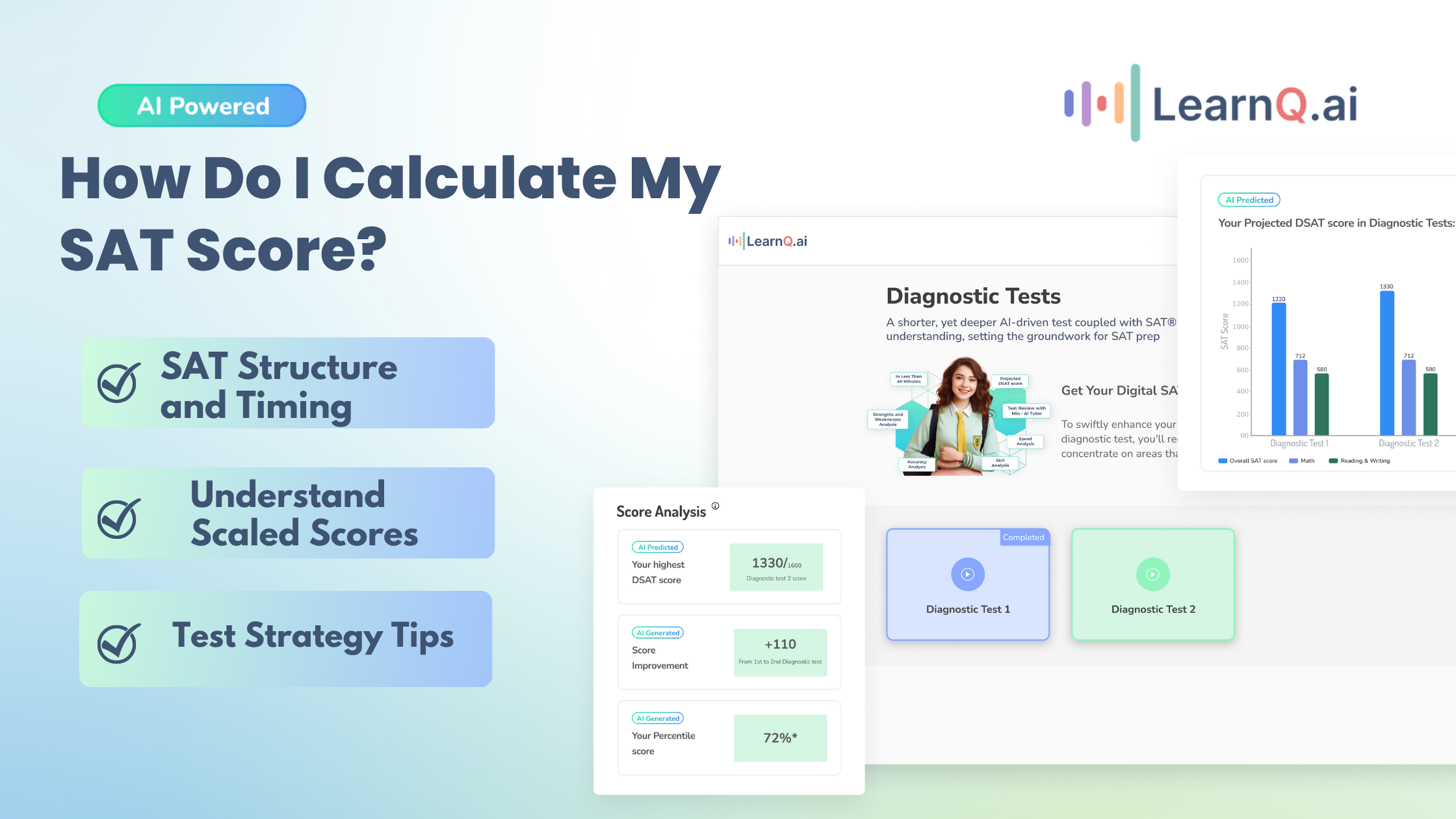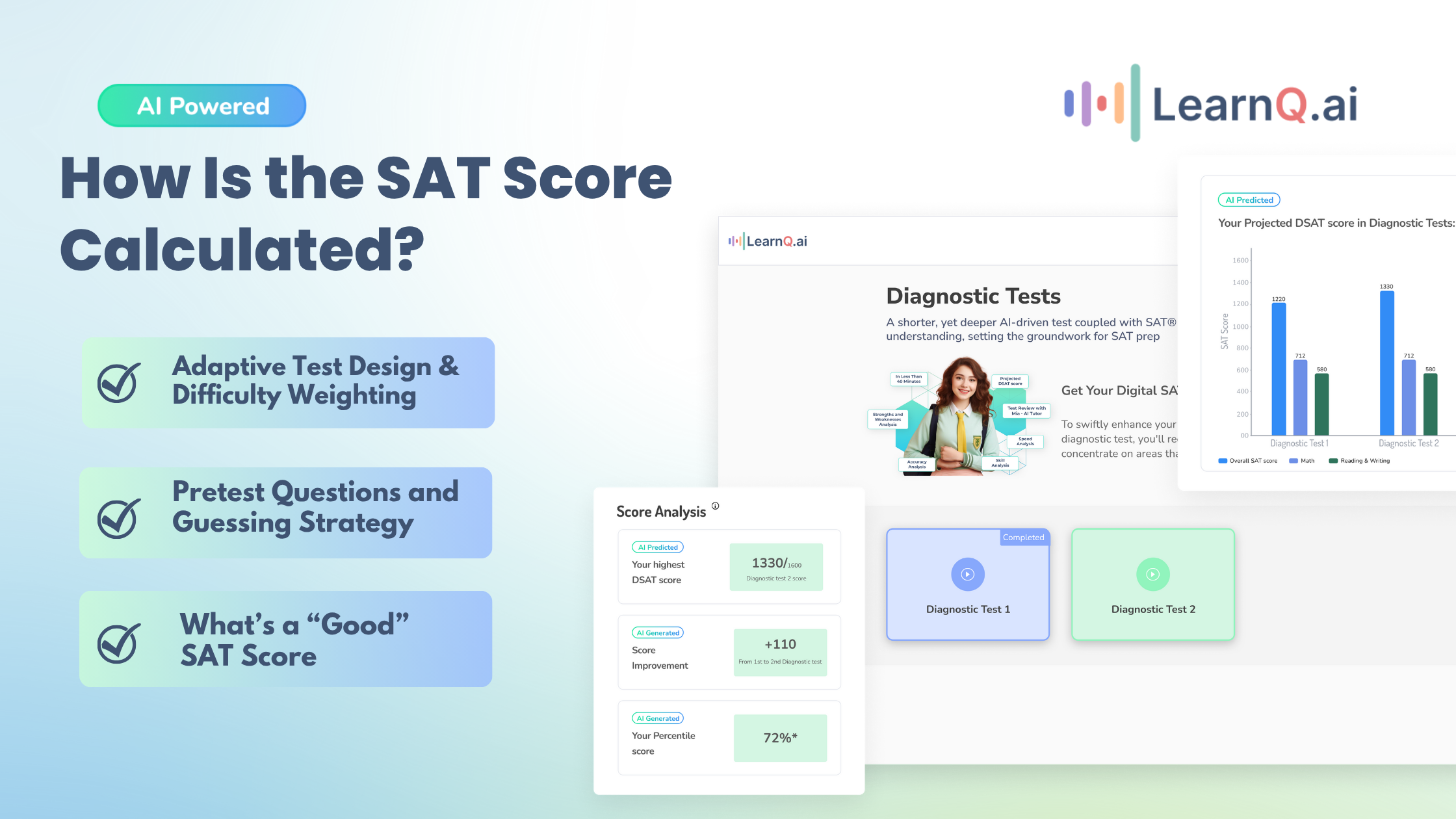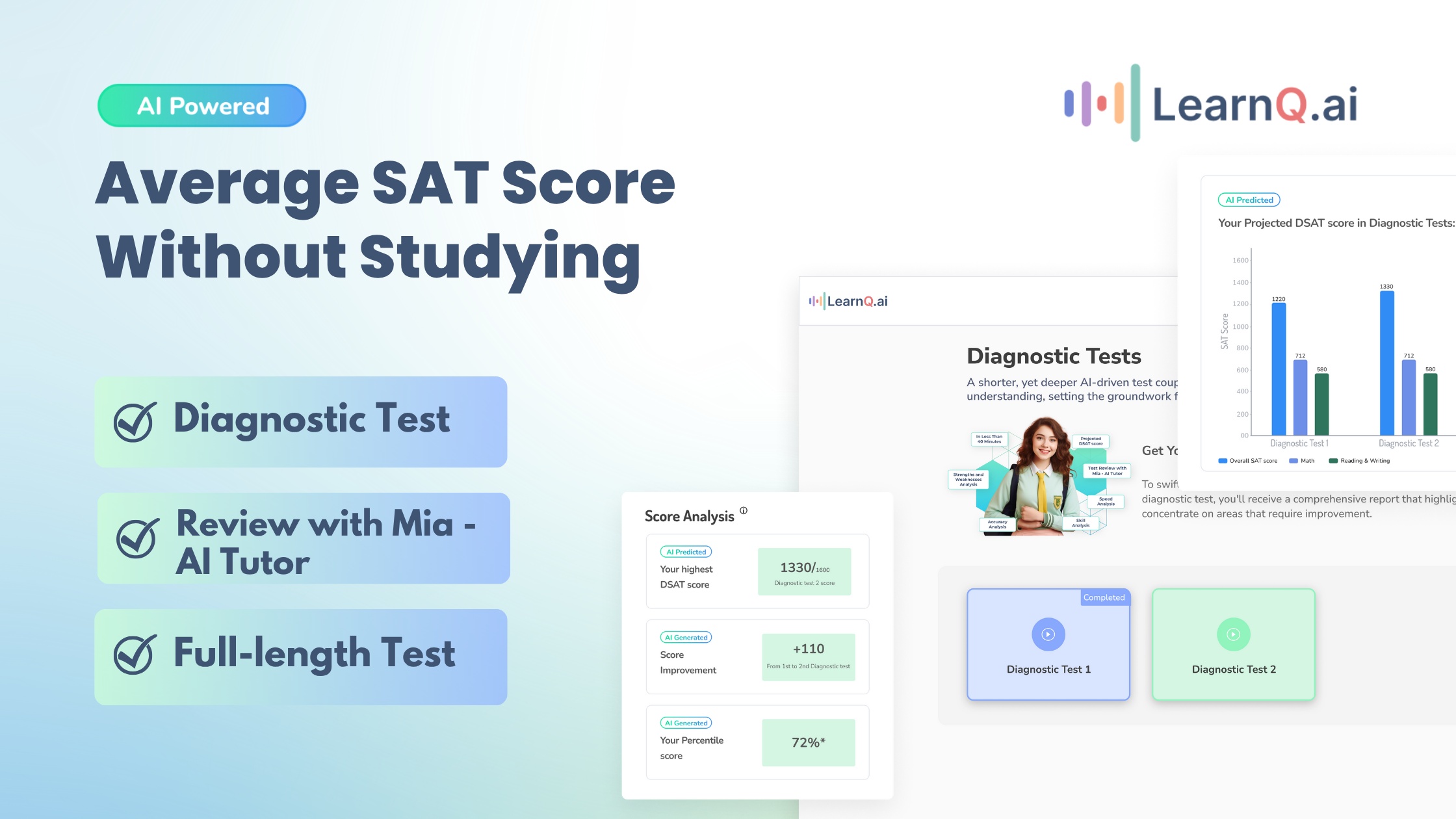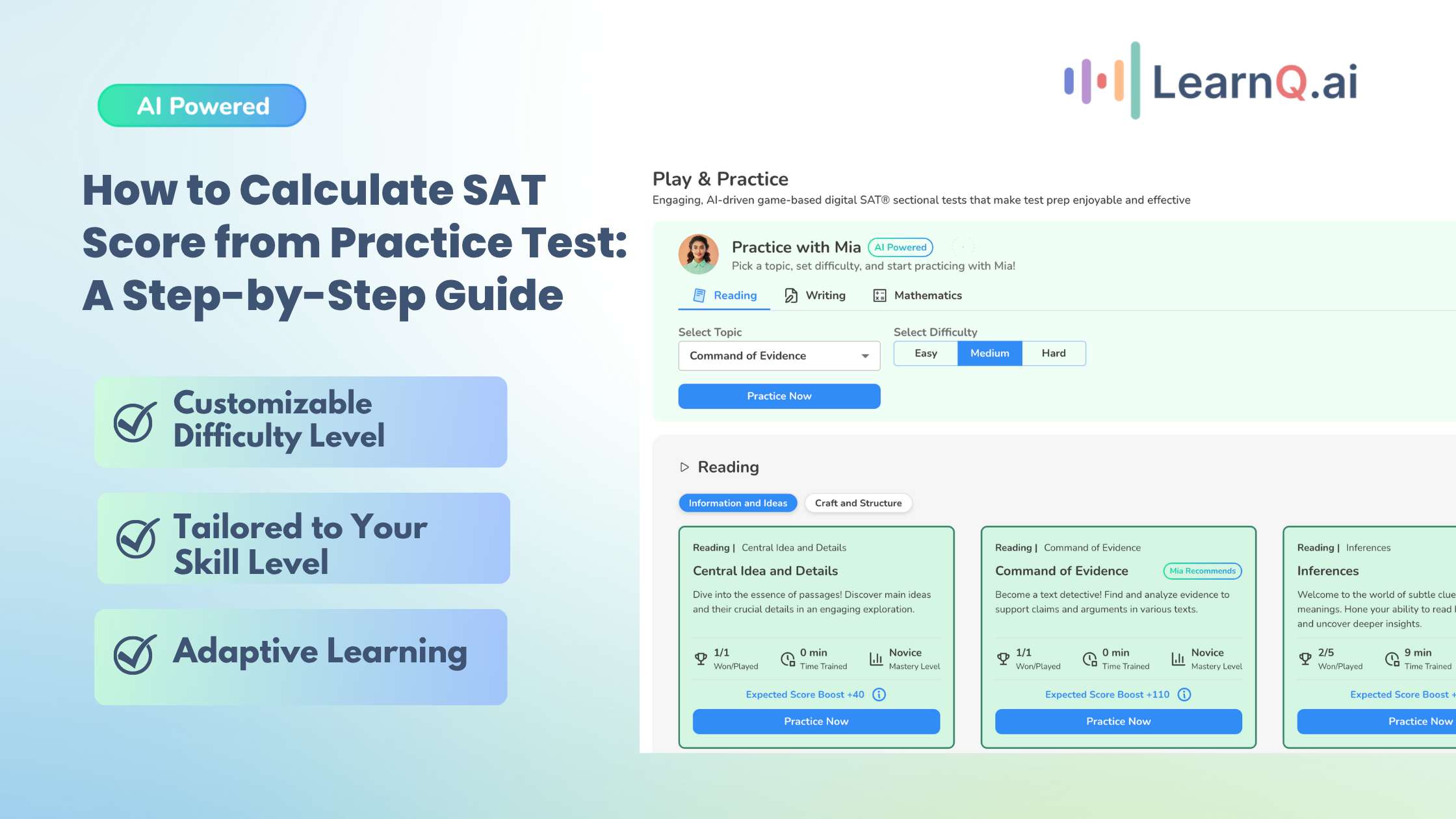Getting ready for college is an exciting time, but preparing for the SATs can feel like a big challenge. As one of the most important exams for college admissions, your SAT score can make a significant difference in where you end up.
For example, scoring 1350 could place you in the top 10% of test-takers, helping your application stand out at competitive schools.
LearnQ.ai is Powered by VEGA AI—Is your Institute Next?
Give students a Duolingo-style test-prep platform with Shopify-level customization for tutors and institutes.
With over 1.9 million students taking the SAT in 2023, the competition is high. But don’t worry! Expensive prep classes aren’t the only way to go about how to practice for the SAT. Self-study is a powerful option that gives students the flexibility to prepare at their own pace.
Whether you’re a student gearing up for the test, a parent guiding your child, or a teacher offering support, this guide will provide key strategies on how to prepare for SAT at home and boost your confidence for test day.
What is SAT Prep?
SAT prep is the process of getting ready for the SAT by studying the material, understanding the exam format, and practicing key test-taking strategies. Think of it like training for a marathon. You wouldn’t show up on race day without conditioning.
In the same way, an effective SAT study plan helps you build confidence in math, reading, and writing so you can perform your best on test day.
For students, starting SAT prep can feel like solving a puzzle. At first, the questions may seem challenging, but with consistent practice, patterns start to emerge, making it easier to solve problems quickly.
Here’s a quick look at the key sections of the SAT and what to expect.
| Component | Time Allotted (minutes) | Number of Questions/Tasks |
| Reading and Writing | 64 (two 32-minute modules) | 54 |
| Math | 70 (two 35-minute modules) | 44 |
| Total | 134 | 98 |
Why Self-Study is Important?
Self-study is essential because it gives you the flexibility to create a schedule that fits your unique needs. Whether you’re juggling extracurricular activities, a part-time job, or family commitments, self-study allows you to tailor your SAT prep to your personal circumstances. This way, you can maintain a balanced routine while still dedicating time to preparing for the test.
For students, this means having control over how and when they study. For parents and teachers, it’s a chance to encourage independent learning that aligns with each student’s pace and needs.
With that in mind, here are some key strategies to help you make the most of your self-study journey and boost your SAT performance.
- Personalization
One of the greatest benefits of self-study is that it allows you to focus on your specific weaknesses. Instead of following a one-size-fits-all curriculum, you can create a personalized SAT plan that targets the areas where you need the most improvement.
This tailored approach ensures that your study time is more effective, helping you strengthen the skills that matter most.
- Self-Motivation
Self-study builds discipline and accountability, as it puts you in charge of setting your own goals and working toward them. For students, this not only helps them prepare for the SAT but also cultivates self-motivation—an essential skill for academic and career success.
As a parent or teacher, you can support this process by encouraging students to take control of their own learning journey. This will make them more confident and self-reliant.
- Complementing Tutoring
Even if you opt for tutoring, self-study is a valuable way to complement those sessions. It reinforces what you’ve learned with your tutor and gives you a chance to dive deeper into difficult topics.
Balancing tutoring with self-study ensures a more comprehensive preparation, allowing you to better practice for the SAT and grasp challenging concepts.
Enhance your Digital SAT study routine with AI-driven insights and personalized practice tests.
Self-Study with LearnQ
If you’re aiming for a top SAT score without spending a fortune on prep courses, LearnQ is here to help you achieve your goals engagingly and effectively. With personalized plans and interactive learning tools, LearnQ transforms the often-daunting task of SAT preparation into a manageable, even enjoyable, journey.
Dive into the standout features that make LearnQ the perfect partner for your self-study success.
- Diagnostic Tests
Before you start studying, it’s important to know where you stand. LearnQ provides diagnostic tests that assess your current level, giving you a predicted SAT score and an in-depth analytics report.
This report highlights your strengths and weaknesses, helping you create a study plan focusing on your improvement areas.
- Custom Study Plans
Based on your diagnostic results, LearnQ generates a personalized 12-week study plan. This plan ensures a focused approach to SAT preparation, helping you work systematically through the topics that need attention. With a clear roadmap, you can stay on track and make the most of your study time.
- Engaging Learning Modes
LearnQ offers various learning modes to keep you engaged throughout your preparation journey. With Mia, LearnQ’s AI companion, you can explore:
- Learning with analogies: Complex topics are broken down using relatable analogies, making them easier to understand.
- Text adventure approach: Engage in an interactive story that helps you entertainingly learn concepts.
- Personalization based on learning styles: Mia tailors content based on your individual learning style, ensuring an optimal learning experience.
- Language flexibility: Learn in any language you’re comfortable with, making complex concepts more accessible.
- Interactive quizzes: Reinforce your understanding with quizzes that provide immediate feedback, helping you identify areas for improvement.
- Practice Topics
To make the most of your study time, LearnQ helps you prioritize topics that offer the highest expected score boost. Using insights from the analytics report, you can focus on practicing these topics first, maximizing your potential score improvement.
- Practice Difficulty
LearnQ allows you to choose the difficulty level of your practice sessions. With Mia’s guidance, you can start with easier questions and gradually work your way up to more challenging problems. This approach helps build your confidence and ensures a deep understanding of each topic.
- Test Review
After each practice test, it’s essential to review your performance to identify areas for improvement. LearnQ makes this process easy with detailed analytics reports and AI-generated recommendations from Mia. Reviewing your test results ensures that you are continually learning from your mistakes and making progress.
- Full-Length Practice Tests
Simulating real exam conditions is crucial for building test-taking stamina. LearnQ offers full-length practice tests that help you get used to the SAT format and timing. Regularly taking these tests helps reduce anxiety and ensures that you are well-prepared for the actual exam day.
Enhance your Digital SAT study routine with AI-driven insights and personalized practice tests.
How to Prepare for Digital SAT?
Preparing for the Digital SAT might feel overwhelming, but knowing what to expect can make all the difference. While these tools are essential, being fully prepared goes far beyond packing your bag.
Mastering the test format, practicing strategically, and staying calm under pressure will set you up for success. Dive into some key strategies to help you feel confident and ready for the Digital SAT.
| Strategy | Details |
| Utilize AI-Based Learning Tools | Leverage AI-powered platforms like LearnQ to receive personalized study plans and instant feedback. |
| Simulate Digital Test Environment | Practice with digital mock exams to get used to the test’s interface and format. |
| Focus on Time Management | Use timed practice tests to improve speed and accuracy for each section of the exam. |
| Review Weak Areas with Analytics | AI-driven reports can highlight your weak areas so you know exactly where to focus your efforts. |
| Adaptive Learning Paths | Tailor your study sessions based on AI insights to make the most of your preparation time. |
| Engage in Interactive Learning | Use digital tools offering quizzes and interactive exercises to reinforce concepts in a fun way. |
| Take Breaks for Better Retention | Incorporate short, regular breaks to prevent burnout and improve retention of studied material. |
| Join Online Study Groups | Connect with peers through online forums like Discord or study groups for motivation and collaborative learning. |
Creating a Study Plan for the SAT
A well-structured study plan is essential for success on the SAT. Whether you’re a student preparing to take the test or a parent or teacher helping guide the process, having a clear and organized plan ensures that every aspect of the exam is covered efficiently.
A strategic approach will help you avoid last-minute cramming, reduce stress, and improve test performance. Here’s a step-by-step guide on how to practice for the SAT that works for your schedule and needs.
- Assess Your Current Level
Before diving into a study plan, it’s important to assess your current strengths and weaknesses. Take an SAT practice test to see where you stand. This will help you identify which sections (math, reading, or writing) require more attention.
Parents and teachers can encourage students to use tools like diagnostic tests, which offer a clear overview of performance areas to improve.
- Set Realistic Goals
Setting measurable goals is crucial. For students, this might mean improving their math score by 50 points or mastering a certain number of new vocabulary words each week.
Breaking larger goals into smaller, achievable milestones will keep them motivated and focused on progress. Teachers and parents can assist by helping create a goal chart that tracks these milestones, ensuring steady progress.
Also Read: Digital SAT Vocabulary Words You Must Know.
- Create a Weekly Study Schedule
Consistency is key when it comes to SAT preparation. Design a weekly schedule that allocates dedicated study time for each subject area. Instead of cramming all at once, spread your study sessions across several weeks or months, focusing on one or two topics per day.
Include regular practice tests to simulate real exam conditions and track your improvement. This schedule should be flexible enough to accommodate extracurricular activities and personal commitments.
- Prioritize High-Impact Areas
Not all SAT sections require the same level of preparation. Based on your practice test results, identify the areas that offer the highest potential for score improvement.
For instance, if you struggle with algebra but excel in reading comprehension, dedicate more time to math while maintaining your strong reading skills. Parents and teachers can help students focus on these high-impact areas to maximize study efficiency.
Also Read: What is the Highest Score on ACT and SAT Tests?
- Practice Under Real Test Conditions
Regularly practicing for the SAT under timed, test-like conditions is one of the most effective ways to prepare for the SAT. Set a timer and complete sections of the test to improve your time management and endurance.
This method reduces anxiety when thinking about how to practice for the SAT and while actually answering the test day, as it simulates the real SAT environment. Parents can ensure a quiet, distraction-free space during these timed practices to mimic actual exam settings.
- Review and Reflect
After each practice test or study session, review your mistakes and understand why you made them. This is where growth happens. Use AI-powered tools or SAT prep platforms that provide detailed analytics, showing where you need to improve.
Teachers can support students by reviewing these areas together, while parents can encourage self-reflection and progress tracking.
- Avoid Last-Minute Cramming
Cramming for the SAT the night before is one of the least effective ways to prepare. While some students wonder how to cram for the SAT effectively, the reality is that it often leads to more stress and less retention.
Instead, aim to complete your major review at least a week before the test date. In the final days, focus on light review and relaxation. A well-structured SAT study plan eliminates the need for last-minute cramming, allowing you to feel confident and well-prepared as the test approaches.
Tips and Strategies to Get the Highest Score with Self-Study
Getting into a top university like Stanford is a dream for many students, and one of the first steps toward making that dream come true is acing the SAT. At Stanford, students not only benefit from world-class academics but also experience fun traditions like the “Wacky Walk.” It is a quirky graduation event where students can express their creativity with costumes and spontaneous performances.
A high SAT score is crucial to participating in such unique traditions, and the good news is that self-study can help you achieve it. Below are some practical tips and strategies for excelling through focused self-study.
Whether you’re a student preparing for the test, a parent guiding your child, or a teacher offering support, dive in.
- Set Realistic Goals: Establish clear, achievable objectives for each study session and week to stay on track without feeling overwhelmed.
- Prioritize High-Impact Topics: Focus on subjects with the highest potential score boost based on diagnostic results, maximizing your study time.
- Utilize Practice Tests: Regularly take full-length practice tests to simulate exam conditions, improving time management and test-taking strategies.
- Review and Reflect: After each practice test, review your mistakes and use LearnQ’s AI recommendations to target areas that need improvement.
- Stay Consistent: Dedicate specific time slots each week to SAT preparation, building a steady routine that ensures continuous progress.
- Play & Practice with Adaptive Digital SAT Prep: Use gamified platforms that adjust to your skill level, making SAT prep more engaging and personalized for better learning.
Also Read: Strategic Steps, Tips, & Templates For Effective Lesson Planning.
LearnQ.ai is powered by VEGA AI—Is your institute next?
Offer students a Duolingo-style test-prep platform with Shopify-level customization for tutors and institutes.






Conclusion
You’ve discovered the best ways to take control of your SAT preparation. From setting achievable goals to creating a personalized study plan, you now know how to practice for the SAT effectively.
With strategies like prioritizing high-impact topics, using practice tests, and avoiding last-minute cramming, you’re setting yourself up for success. Whether you’re a student gearing up for the test, a parent supporting your child, or a teacher offering guidance, these self-study tips will help you feel confident on test day.
Want to elevate your SAT prep even more? LearnQ’s personalized learning tools are used by students and teachers in over 190 countries and endorsed by top SAT prep institutes. Start learning smarter with LearnQ today!

